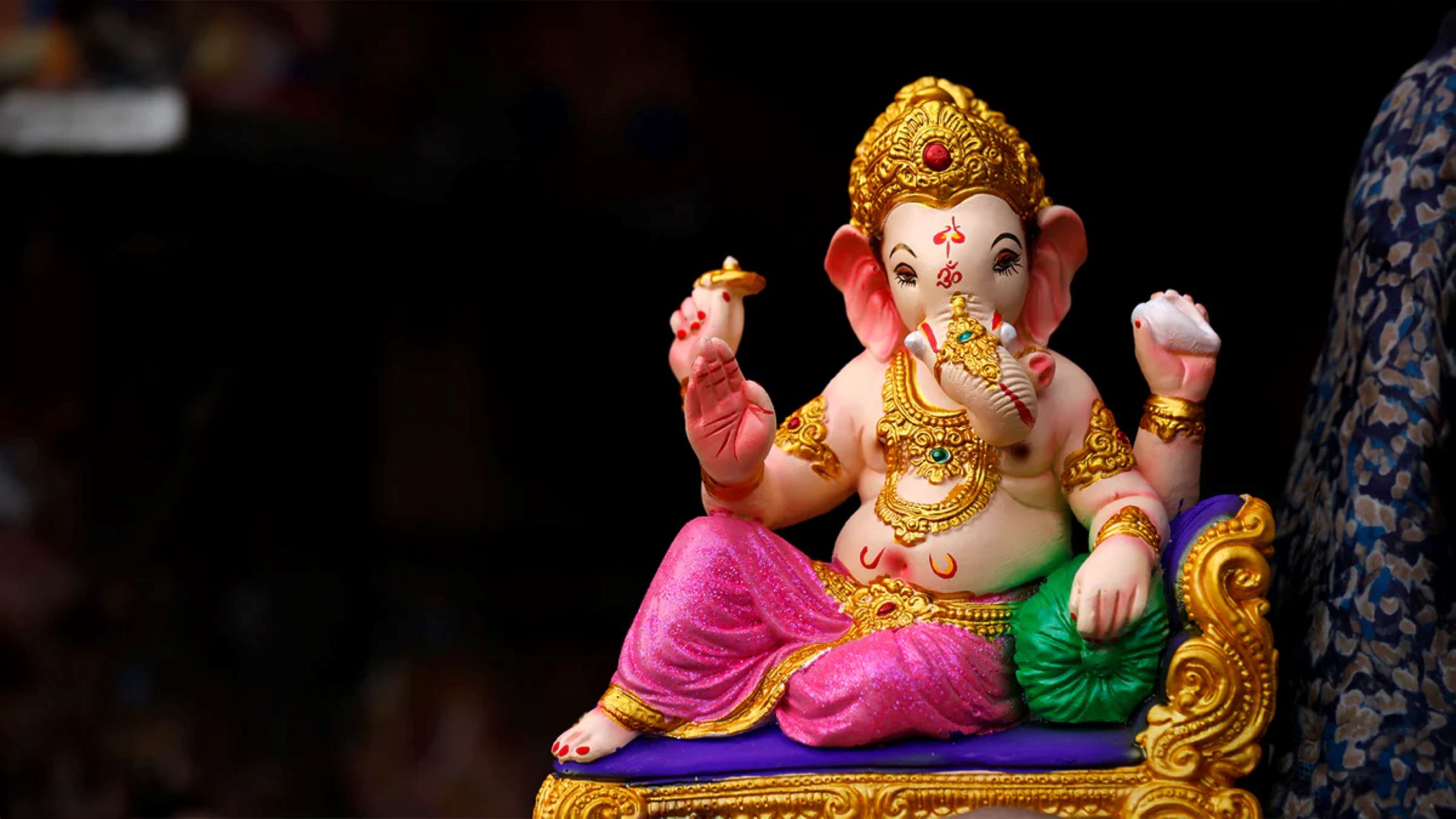Home>Arts and Culture>Lord Ganesha’s Brother: The Lesser-Known Deity You Need To Know


Arts and Culture
Lord Ganesha’s Brother: The Lesser-Known Deity You Need To Know
Published: February 12, 2024
Discover the fascinating deity rarely spoken about - Lord Ganesha's brother. Uncover the rich cultural significance in arts and culture.
(Many of the links in this article redirect to a specific reviewed product. Your purchase of these products through affiliate links helps to generate commission for Regretless.com, at no extra cost. Learn more)
Table of Contents
Introduction
In the vast and diverse tapestry of Hindu mythology, there are countless deities, each with their own unique stories, symbolism, and significance. While many are familiar with the beloved elephant-headed Lord Ganesha, there is another deity who is often overshadowed by his brother's widespread popularity. This lesser-known deity is none other than Lord Ganesha's brother, Kartikeya, also known as Murugan, Skanda, or Subramanya.
Kartikeya holds a special place in Hindu mythology and is revered for his valor, wisdom, and divine attributes. His compelling tale and symbolic representation offer a fascinating glimpse into the rich tapestry of Hindu culture and spirituality. As we delve into the mythological background, depiction, worship, and significance of Lord Ganesha's brother, we will uncover the captivating essence of Kartikeya and the profound impact he holds within Hinduism.
Read more: 10 Lesser-Known Animals That Start With “L”
The Mythological Background
In Hindu mythology, the tale of Lord Ganesha's brother, Kartikeya, is steeped in captivating narratives and profound symbolism. According to ancient scriptures and legends, Kartikeya is the son of Lord Shiva, the supreme god known as the destroyer, and his consort Parvati, the goddess of fertility, love, and devotion.
The mythological saga of Kartikeya's birth is a fascinating account of divine intervention and cosmic significance. It is said that the demon Tarakasura had wreaked havoc and threatened the very fabric of the universe. The gods, unable to vanquish him, sought the assistance of Lord Shiva. However, Shiva was immersed in deep meditation and was unaware of the impending catastrophe. In response to the gods' plea, the divine feminine energy, Parvati, resolved to create a son who would possess the power to defeat Tarakasura.
Parvati's intense penance and unwavering devotion led to the manifestation of Kartikeya, a radiant and valorous being with six heads, symbolizing his mastery over the five senses and the mind. Endowed with immense wisdom, courage, and divine weaponry, Kartikeya embarked on a heroic quest to confront and vanquish the malevolent demon, thus restoring cosmic harmony.
This mythological narrative not only showcases Kartikeya's inherent divinity but also underscores the profound bond between a mother and her son, as well as the eternal struggle between good and evil. Kartikeya's birth and his subsequent triumph over adversity exemplify the timeless themes of righteousness, maternal love, and the eternal cosmic balance, which resonate deeply within Hindu mythology and philosophy.
The enthralling mythological background of Kartikeya sets the stage for a deeper exploration of his depiction, symbolism, worship, and significance within Hinduism, offering a rich tapestry of cultural, spiritual, and philosophical insights.
This comprehensive understanding of Kartikeya's mythological background serves as a gateway to appreciating the multifaceted layers of Hindu mythology and the enduring relevance of its timeless tales.
The Depiction and Symbolism of Lord Ganesha's Brother
Kartikeya, the illustrious brother of Lord Ganesha, is depicted as a resplendent and valorous deity, embodying attributes that resonate deeply within Hindu culture and spirituality. In artistic representations, Kartikeya is often portrayed as a handsome and youthful figure, adorned with divine regalia and wielding powerful weaponry. His most prominent symbol is the peacock, which serves as his vahana, or mount, symbolizing grace, beauty, and the conquest of ego.
The symbolism embedded within Kartikeya's depiction is multifaceted and rich in allegorical significance. His six heads are emblematic of his mastery over the five senses and the mind, highlighting his transcendence beyond worldly temptations and distractions. Additionally, his radiant countenance and divine attributes symbolize purity, wisdom, and unwavering determination in the pursuit of righteousness.
Furthermore, Kartikeya is often depicted holding a spear or vel, a potent weapon that embodies his indomitable spirit and his role as a divine warrior. This symbolizes his ability to pierce through ignorance and vanquish inner and outer obstacles, inspiring devotees to emulate his fearlessness in confronting life's adversities.
The peacock, with its vibrant plumage and regal bearing, serves as a profound symbol of Kartikeya's divine grace and his ability to transmute worldly desires and attachments into spiritual beauty and harmony. The peacock's association with Kartikeya also represents the subjugation of pride and arrogance, reminding devotees of the importance of humility and inner transformation.
In essence, the depiction and symbolism of Lord Ganesha's brother, Kartikeya, encapsulate a profound tapestry of virtues, values, and spiritual ideals. His portrayal as a divine warrior, wise philosopher, and compassionate guide resonates with the timeless ethos of dharma (righteousness) and the eternal quest for inner awakening and transcendence.
This rich symbolism not only enriches the artistic and mythological representation of Kartikeya but also serves as a source of inspiration and contemplation for devotees seeking to imbibe his noble qualities in their own spiritual journey.
The Worship and Festivals
The worship of Lord Kartikeya, the revered brother of Lord Ganesha, holds a significant place in Hindu traditions and is celebrated with fervor and devotion. Devotees across India and various parts of the world pay homage to Kartikeya through elaborate rituals, prayers, and vibrant festivals that honor his divine presence.
One of the most prominent and widely celebrated festivals dedicated to Lord Kartikeya is the Skanda Shashti, which commemorates his victory over the demon Tarakasura. This six-day festival, observed in the lunar month of Kartika, is marked by fasting, spiritual recitations, and processions that culminate in grand celebrations on the final day. Devotees express their reverence for Kartikeya through devotional songs, hymns, and the reenactment of his valiant exploits, symbolizing the triumph of good over evil.
In South India, the festival of Thaipusam is a spectacular manifestation of devotion and spiritual fervor dedicated to Lord Murugan, another form of Kartikeya. This vibrant festival features awe-inspiring processions, where devotees embark on arduous pilgrimages, often carrying kavadis – ornately decorated structures – as a demonstration of their unwavering faith and gratitude towards Lord Murugan. The fervent atmosphere, pulsating with the rhythmic beats of drums and the fervent chants of devotees, reflects the deep-seated reverence and adoration for Kartikeya.
The worship of Kartikeya extends beyond these grand festivals, permeating daily rituals and spiritual practices. Devotees offer prayers at Kartikeya temples, seeking his blessings for courage, wisdom, and protection from obstacles. The Arupadaiveedu, a group of six sacred temples dedicated to Kartikeya in Tamil Nadu, exemplifies the enduring legacy of his worship and the profound impact of his divine presence on devotees.
Throughout the year, devotees partake in various forms of worship, including abhishekam (ritual bathing of the deity), archana (offering of prayers), and the lighting of lamps as expressions of reverence and gratitude towards Lord Kartikeya. The spiritual significance of Kartikeya's worship lies in its ability to inspire devotees to cultivate courage, perseverance, and spiritual fortitude in their lives, drawing strength from his divine attributes and benevolent grace.
The worship and festivals dedicated to Lord Kartikeya not only serve as occasions for communal harmony and spiritual rejuvenation but also stand as a testament to the enduring legacy of his divine presence in Hindu culture and the hearts of devotees worldwide.
The Significance in Hinduism
The significance of Lord Kartikeya, the lesser-known deity and brother of Lord Ganesha, reverberates deeply within the tapestry of Hinduism, encapsulating profound spiritual, cultural, and philosophical dimensions. As a revered deity embodying valor, wisdom, and divine grace, Kartikeya holds a distinct place in Hindu mythology and spiritual consciousness.
In Hinduism, Kartikeya is venerated as the epitome of courage, righteousness, and spiritual evolution. His portrayal as a divine warrior and philosopher serves as a timeless inspiration for devotees, symbolizing the indomitable spirit required to confront life's adversities with unwavering determination and inner strength. The significance of Kartikeya's presence in Hinduism lies in his role as a guiding force, inspiring devotees to cultivate virtues such as fearlessness, wisdom, and compassion in their spiritual journey.
Furthermore, Kartikeya's symbolism as the conqueror of ego and ignorance holds profound significance within Hindu philosophical traditions. His mastery over the senses and the mind serves as a poignant reminder of the transformative power of self-discipline and introspection in transcending worldly attachments and attaining spiritual liberation. Devotees often seek Kartikeya's blessings to overcome inner obstacles and attain clarity of purpose on the path of righteousness.
Moreover, Kartikeya's familial ties to Lord Ganesha, the widely revered deity known for removing obstacles, accentuate the interconnectedness of divine energies within Hindu cosmology. The harmonious relationship between the brothers symbolizes the complementary forces of wisdom and obstacle removal, offering devotees a holistic approach to navigating life's challenges with grace and resilience.
In Hindu mythology and spiritual discourse, the significance of Lord Kartikeya extends beyond his individual attributes, encompassing his role as a unifying force that bridges devotees to the transcendent realms of courage, wisdom, and inner transformation. His divine presence in Hinduism serves as a source of inspiration, guiding devotees towards the pursuit of righteousness, the conquest of inner demons, and the attainment of spiritual illumination.
Ultimately, the significance of Lord Kartikeya in Hinduism lies in his embodiment of timeless virtues and his enduring presence as a beacon of courage and wisdom, inspiring devotees to tread the path of righteousness and inner awakening with unwavering resolve and devotion.
Read more: Top Greek Actors You Need To Know
Conclusion
In conclusion, the exploration of Lord Ganesha's brother, Kartikeya, has unveiled a captivating tapestry of mythology, symbolism, worship, and significance within Hindu culture and spirituality. From the enthralling mythological background that narrates his divine birth to the profound symbolism embedded within his artistic depictions, Kartikeya emerges as a compelling deity embodying valor, wisdom, and grace.
The worship and festivals dedicated to Lord Kartikeya, such as Skanda Shashti and Thaipusam, stand as vibrant testaments to the enduring reverence and adoration for this lesser-known deity. These celebrations not only foster communal harmony but also serve as occasions for spiritual rejuvenation, inspiring devotees to embody courage, perseverance, and inner transformation.
The significance of Lord Kartikeya in Hinduism extends beyond his individual attributes, encompassing his role as a unifying force that bridges devotees to the transcendent realms of courage, wisdom, and inner transformation. His divine presence serves as a source of inspiration, guiding devotees towards the pursuit of righteousness, the conquest of inner demons, and the attainment of spiritual illumination.
In essence, the exploration of Lord Kartikeya's mythology and symbolism offers a profound insight into the rich tapestry of Hindu culture and spirituality. His enduring presence as a beacon of courage and wisdom inspires devotees to tread the path of righteousness and inner awakening with unwavering resolve and devotion. As we conclude this journey into the realm of Lord Ganesha's lesser-known brother, Kartikeya, we are reminded of the timeless virtues and spiritual ideals that continue to resonate deeply within the hearts and minds of devotees, enriching their lives with courage, wisdom, and divine grace.














